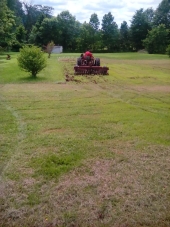
 1
1




"Solve world hunger . . . tell no one." The, the, the, . . . THE GRINCH!




 3
3




George Collins wrote:So, what is the permaculture answer to growing acres of corn?
Our Microgreens: http://www.microortaggi.it




Idle dreamer

 1
1




 1
1




Diversified Food forest maker . Fill every niche and you'll have less weeds (the weeds are the crop too). Fruit, greens, wild harvest, and nuts as staple. Food processing and preservation are key to self self-sufficiency. Never eat a plant without posetive identification and/or consulting an expert.




Diversified Food forest maker . Fill every niche and you'll have less weeds (the weeds are the crop too). Fruit, greens, wild harvest, and nuts as staple. Food processing and preservation are key to self self-sufficiency. Never eat a plant without posetive identification and/or consulting an expert.

 1
1




Jeffrey Hodgins wrote:
Cows will choose corn over grass every time I know because I feed them both.
I grow corn with pole beans and squash. I still till the soil. I have been growing some experimental no till plots with little success even if the soil is high in organic matter. For no till corn I have yet to find a viable system but I don't think we should give up so easily. The aztecs grew corn on lake bottoms in black muck the black muck is now gone due to constant turning of the soil. The best hope for improving corn imo is Zea mays diploperennis, unfortunately it's not on the market yet. If anyone knows where to get Zea mays diploperennis seed please post a link
Sustainable Plantations and Agroforestry in Costa Rica
 1
1




"Solve world hunger . . . tell no one." The, the, the, . . . THE GRINCH!




Diversified Food forest maker . Fill every niche and you'll have less weeds (the weeds are the crop too). Fruit, greens, wild harvest, and nuts as staple. Food processing and preservation are key to self self-sufficiency. Never eat a plant without posetive identification and/or consulting an expert.











George Collins wrote:...he wants to plant enough to use as feed to over-winter livestock. ...
So, what is the permaculture answer to growing acres of corn?
My project thread
Agriculture collects solar energy two-dimensionally; but silviculture collects it three dimensionally.




Buy Our Book! Food Web: Concept - Raising Food the Right Way. Learn make more food with less inputs
Off Grid Homesteading - latest updates and projects from our off grid homestead
 1
1




George Collins wrote:I have friend recently introduced to the world of permaculture. I loaned him my Ruth Stout book which he quickly devoured. Being the smart feller he is, he instantly recognized the merits of her system.
My project thread
Agriculture collects solar energy two-dimensionally; but silviculture collects it three dimensionally.




George Collins wrote:The livestock inquestion isn't cows, rather it's hogs.
My friend lives in the middle of a large pine desert with some pockets of fertility.
I know that growing large plots of corn is generally frowned upon by many in the Permaculture community.
My project thread
Agriculture collects solar energy two-dimensionally; but silviculture collects it three dimensionally.




Diversified Food forest maker . Fill every niche and you'll have less weeds (the weeds are the crop too). Fruit, greens, wild harvest, and nuts as staple. Food processing and preservation are key to self self-sufficiency. Never eat a plant without posetive identification and/or consulting an expert.




Jeffrey Hodgins wrote:The way I have seen Mexicans grow corn is not good.
My project thread
Agriculture collects solar energy two-dimensionally; but silviculture collects it three dimensionally.
 1
1




Pastured pork and beef on Vashon Island, WA.
 1
1


















Brenda
Bloom where you are planted.
http://restfultrailsfoodforestgarden.blogspot.com/
 1
1




Diversified Food forest maker . Fill every niche and you'll have less weeds (the weeds are the crop too). Fruit, greens, wild harvest, and nuts as staple. Food processing and preservation are key to self self-sufficiency. Never eat a plant without posetive identification and/or consulting an expert.




we don't have a problem with lack of water we have a problem with mismanagement
beavers the original permies farmers
If there is no one around to smell you ,do you really stink!




we don't have a problem with lack of water we have a problem with mismanagement
beavers the original permies farmers
If there is no one around to smell you ,do you really stink!




jimmy gallop wrote:If I was to grow corn for cows I would feed the whole plant to them they eat all of it just like it was a blade of grass
don't know why they separate them
My project thread
Agriculture collects solar energy two-dimensionally; but silviculture collects it three dimensionally.


















|
Forget this weirdo. You guys wanna see something really neat? I just have to take off my shoe .... (hint: it's a tiny ad)
Learn Permaculture through a little hard work
https://wheaton-labs.com/bootcamp
|






